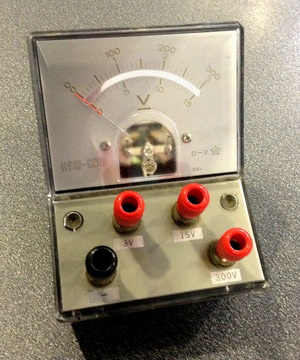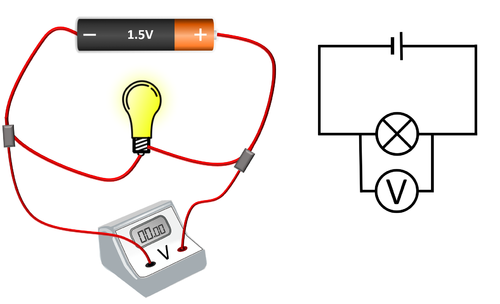Difference between revisions of "Voltmeter"
| Line 5: | Line 5: | ||
===About Voltmeters=== | ===About Voltmeters=== | ||
| − | : [[Voltmeter]]s are added in [[parallel]] to [[component]]s in a [[circuit]] to find the [[Potential Difference|potential difference]] between two points. | + | : [[Voltmeter]]s are added in [[Parallel Circuit|parallel]] to [[component]]s in a [[circuit]] to find the [[Potential Difference|potential difference]] between two points. |
: An ideal [[voltmeter]] has infinite [[Electrical Resistance|resistance]] because otherwise adding an [[voltmeter]] to a [[circuit]] would change the [[Potential Difference]] between two points. | : An ideal [[voltmeter]] has infinite [[Electrical Resistance|resistance]] because otherwise adding an [[voltmeter]] to a [[circuit]] would change the [[Potential Difference]] between two points. | ||
: [[Voltmeter]]s can be [[Analogue Voltmeter|analogue]] with a needle pointing to numbers on a dial or it can be [[Digital Voltmeter|digital]] with a number display. | : [[Voltmeter]]s can be [[Analogue Voltmeter|analogue]] with a needle pointing to numbers on a dial or it can be [[Digital Voltmeter|digital]] with a number display. | ||
Revision as of 13:35, 25 February 2019
Key Stage 3
Meaning

A picture showing an analogue voltmeter.
A voltmeter is a measuring device used to measure the Potential Difference between two points in a circuit.
About Voltmeters
- Voltmeters are added in parallel to components in a circuit to find the potential difference between two points.
- An ideal voltmeter has infinite resistance because otherwise adding an voltmeter to a circuit would change the Potential Difference between two points.
- Voltmeters can be analogue with a needle pointing to numbers on a dial or it can be digital with a number display.
| A voltmeter placed in parallel with a bulb. |
